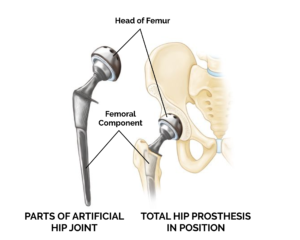Hip Replacement- Bilateral
Bilateral hip replacement, also known as total hip arthroplasty, is a surgical procedure performed to replace both hip joints simultaneously. This procedure is typically recommended for individuals with severe hip arthritis or other conditions that cause significant pain, stiffness, and loss of mobility in both hips. By replacing both hip joints, bilateral hip replacement aims to restore function, relieve pain, and improve quality of life.

Who Needs Hip Replacement – Bilateral
Bilateral hip replacement may be recommended for individuals who meet the following criteria:
Severe hip arthritis: When non-surgical treatments such as medications, physical therapy, and assistive devices fail to provide adequate relief from pain and functional limitations caused by severe hip arthritis in both hips.
Bilateral hip joint degeneration: When both hip joints are affected by conditions like osteoarthritis, rheumatoid arthritis, avascular necrosis, or post-traumatic arthritis.
Symmetrical hip pain and disability: When the pain, stiffness, and loss of function in both hips are similar and significantly affect daily activities and quality of life.
When to See a Specialist
If you experience the following symptoms, it is advisable to consult a specialist for a comprehensive evaluation:
Persistent hip pain, especially during weight-bearing activities or at rest.
Difficulty walking, climbing stairs, or performing routine movements due to hip pain and stiffness.
Stiffness in both hips limits mobility and affects your ability to carry out daily tasks.
Procedure
Preoperative assessment: Before the surgery, you will undergo a thorough physical examination, medical history review, and imaging tests (X-rays, MRI) to evaluate the condition of your hips and determine the surgical approach.
Anesthesia: Bilateral hip replacement is typically performed under general anesthesia, ensuring that you are unconscious and pain-free throughout the procedure.
Incision: The surgeon will make incisions on both sides of the hips, exposing the affected hip joints.
Preparation of the hip socket: The damaged cartilage and bone in the hip socket (acetabulum) are removed and reshaped to accommodate the prosthetic cup.
Placement of the artificial hip components: The surgeon will insert the prosthetic socket (cup) into the hip socket and secure it using screws or cement. Then, a prosthetic femoral stem is inserted into the thigh bone (femur), and a prosthetic femoral head is attached to the stem.
Closure and recovery: The incisions are closed with sutures or staples, and dressings are applied to protect the surgical sites. Drainage tubes may be inserted to remove excess fluid. Afterward, you will be transferred to the recovery area for monitoring.
Risk
Coronary angiography is a safe procedure, but as with any medical test, there are some risks. The most common risks include bleeding or bruising at the catheter insertion site, allergic reaction to the contrast dye, and damage to the blood vessels or other organs. Your doctor will discuss the risks and benefits of the test with you before the procedure.
Benefits of Coronary Angiography
Coronary angiography can help your doctor diagnose and treat heart disease. By identifying blockages in the coronary arteries, the test can help determine the most appropriate treatment, which may include angioplasty or stenting. The procedure is also useful for monitoring the progress of treatment and assessing the effectiveness of medications.
Frequently Asked Questions
1. What is coronary angiography?
Coronary angiography is a medical procedure that involves the use of contrast dye and X-ray imaging to examine the coronary arteries in the heart.
2. How is a coronary angiography performed?
During coronary angiography, a long, thin tube (catheter) is inserted into an artery in the groin or arm and carefully guided to the coronary arteries. Contrast dye is then injected through the catheter while X-ray images are taken to visualize the blood flow in the heart.
3. Is coronary angiography painful?
Most patients do not experience significant pain during a coronary angiography procedure. Local anesthesia is used to numb the area where the catheter is inserted, and sedatives may be given to help patients relax.
4. How long does a coronary angiography take?
The procedure itself usually takes less than an hour, but patients are typically monitored for several hours afterward to ensure there are no complications.
5. What are the risks of coronary angiography?
While coronary angiography is generally considered a safe procedure, there are some risks, including bleeding or bruising at the site where the catheter is inserted, allergic reactions to the contrast dye, damage to the blood vessels or surrounding organs, and rarely, heart attack or stroke.
Treatians As The Best Choice
Treatians understand that seeking medical treatment abroad can be a daunting experience for patients and their families. That’s why the company offers end-to-end support to its clients, from the initial consultation to post-treatment care. The company provides personalized treatment plans that are tailored to meet the individual needs of each patient, and its team of dedicated professionals is always on hand to provide guidance and support throughout the entire process. Contact us at +91-7982312582, drop your email [email protected]
- Trauma & intensive care
- Aged Care
- Community Services
- Diagnosis & Investigation
- Medical & Surgical
- Mental Health
- Rehabitation
- Specialised Support Service



















